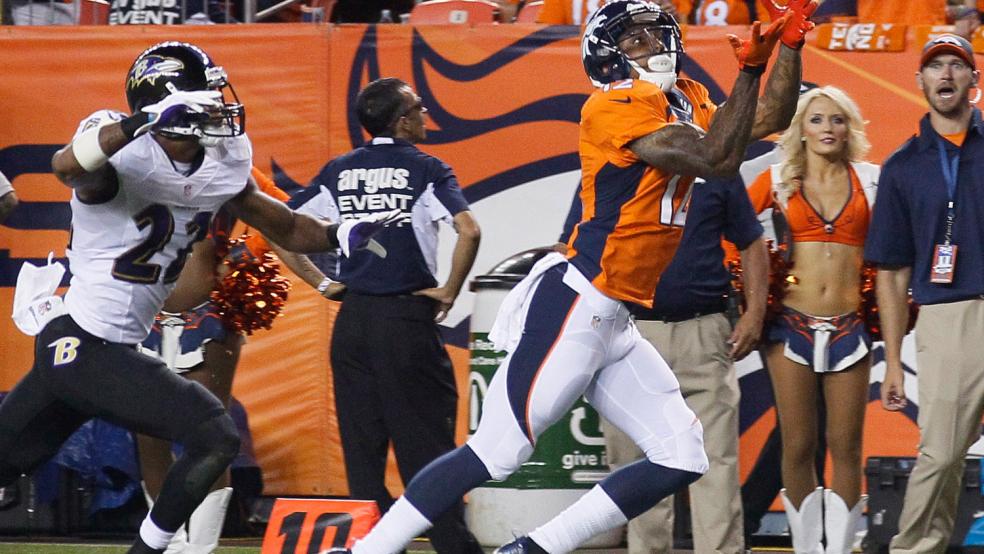The gladiators of the gridiron are back. The National Football League officially kicked off its 94th season Thursday night, but Sunday brings its first full slate of games – and with it, a full-fledged revving of the economic engine that is America’s favorite, and most profitable, sport.
Commissioner Roger Goodell has set an aggressive goal of getting the league to $25 billion in revenue by 2027. It has a long way to go, but is clearly ahead of other major sports. The NFL generated $9.5 billion in revenues in 2012 , some $2 billion more than Major League Baseball. The 32 teams themselves are worth more than $37 billion combined, according to Forbes .
SMALL SCREEN, BIG MONEY
The NFL’s revenue includes $4 billion from television broadcast rights contracts with the likes of CBS, ESPN, Fox, NBC and satellite provider DirecTV. Those TV revenues are set to go up to $5 billion starting next year. The league can attract such TV prices because its games consistently draw strong ratings, particularly with viewers in the 18- to 49-year old demographic group that advertisers covet. The Super Bowl, of course, gets monster viewership year after year, but regular season and even preseason games consistently get millions of fans to watch – and watch live, when they’re more likely to see ads that they might skip on a recorded program.
NBC’s “Sunday Night Football” was the top-rated show among those viewers over the 2012-2013 television season , though it was beaten out by CBS drama “ NCIS” among viewers overall.
THE FANS
Yet the league’s current economic impact reaches well beyond its own TV deals or sales of tickets and merchandise. It extends to sales of everything from beer and chicken wings to flat-screen TVs and high-end sound systems. Chances are, it even extends to your office. Once a subculture for dedicated stathead fans, fantasy sports have exploded in popularity, with football leading the way. More than 25 million Americans played fantasy football last year, spending more than $3 billion on league entry fees and other related content and services, including stuff like this.
Outplacement firm Challenger, Gray & Christmas noted in a press release last week that it may be virtually impossible to calculate the productivity costs of millions of workers minding their teams on company time – but that didn’t deter the firm from taking a stab at it anyway. Using government data on average hourly earnings and assuming employees work on their teams for an hour a week, the firm roughly estimated a productivity hit of nearly $8.3 billion over a full fantasy season, even while acknowledging their math might be meaningless – and that a little time spent on a fantasy team could improve office morale and overall worker productivity.
“So, what’s the point of this non-scientific study?” CEO John Challenger asked in the release. “It is simply to acknowledge that fantasy football is a massively popular phenomenon that cannot be ignored.”
34: Percentage of fans who said that pro football was their favorite sport in a January poll by Harris Interactive , compared with 24 percent who chose pro football in 1985. Baseball was a distant second in the most recent poll, with 16 percent calling it their favorite.
17,303,347: Regular season attendance at NFL games in 2012, according to Sports Business Journal, up from 2011 but down from 17,605,811 in 2006.
$2.3 Billion: Value of the Dallas Cowboys, according to Forbes. The team had operating income of more than $250 million.
$825 Million: Value of the Oakland Raiders, the lowest of any franchise in the NFL.
$3.5 Million: Operating loss last season for the Detroit Lions, the only team in the league to be in the red, according to Forbes.
$1.1 Billion: Value of the five-year contract agreed to by Nike in 2012 to become the NFL’s official uniform provider.
$1 Billion: Value of the four-year contract agreed to by Verizon Wireless in June to live-stream NFL games. The deal takes effect in 2014.
17: Number of billionaires among the league’s 31 owners (with the Green Bay Packers being publicly owned ) .
$29.5 Million: Compensation paid by the league to Commissioner Roger Goodell in 2011, more than many CEOs of Fortune 500 companies received.
501(c)(6): Section of the tax code that explicitly grants professional football leagues that are not organized for profit a tax exemption. The NFL league office does not pay taxes because of that exemption, written into law in 1966, but the 32 individual teams do. Sen. Tom Coburn (R-OK) has proposed to end that exemption.
110,000: Approximate number of jobs across various industries supported by the NFL, according to a 2011 story by the Associated Press.
$765 million: Amount the NFL agreed to pay over 20 years to settle a lawsuit brought by 4,500 former players who accused the league of concealing information it had about the long-term risks of concussions. The league did not admit to any wrongdoing in agreeing to the settlement, which must still be approved by a federal judge.
1,496: Injuries that sidelined a player for eight or more days during the 2012 season, up 37 percent from 1,095 in the 2009 season, according to an analysis of NFL data by Edgeworth Economics.
$22,344,408: Compensation due for the 2013 season to 24 NFL players who had torn their anterior cruciate ligaments as of mid-August, according to Spotrac . All but one of the players are expected to miss the full season.





